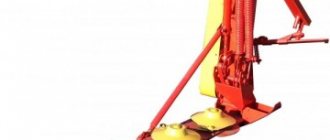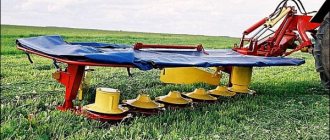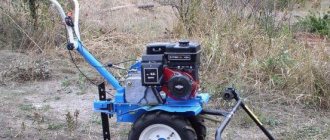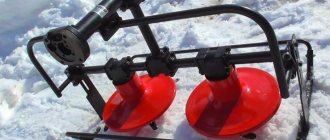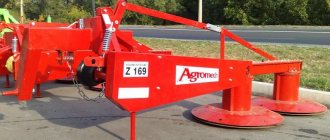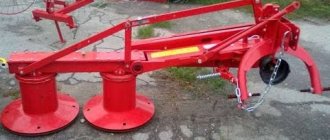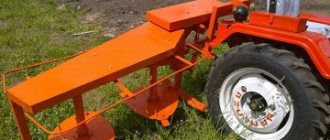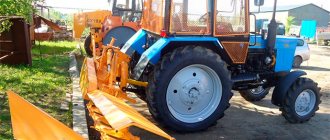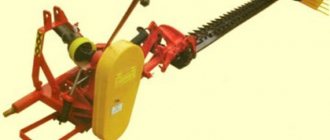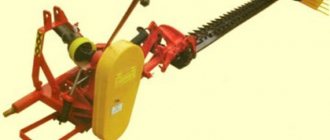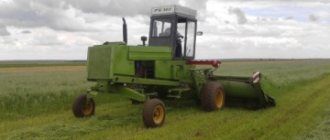Service Features
One of the main advantages of rotary models is that they require virtually no technical knowledge for operation and maintenance. Farmers choose such equipment because of its simplicity of design and the absence of the need for frequent repairs. You will need to monitor the condition of the device, because spare parts for trailed mowers wear out over time and require replacement or maintenance. The repair is simple and can be done by one person.
For efficient operation, lubricant and parts are checked for malfunction or damage, and adjustments
nodes and chains.
The need for frequent maintenance of a segment mower depends on its model. Attachments for large equipment may require this on a daily basis and at the end of the working season. The mower for any tractor is cleaned of dirt, grass and other things, and the reliability of fastening the knives of the cutting plate is checked. Periodically, the elements will need to be sharpened or replaced, and lubrication is also required. Segment mower
more difficult to maintain because it has a more complex structure and a labor-intensive hanging process.
Main problems and malfunctions of the carburetor.
Grid There are only two problems with this element:
- Clogging.
- Violation.
To determine the cause of the problem, unscrew the fuel filter cap to remove the strainer. If dirt has simply accumulated on it, washing with gasoline or blowing it out will help.
Be sure to install a new filter if there is any visible damage. There may also be damage to the fuel line (check this point during repair).
In most cases, the carburetor starter does not work due to blockages. For washing, use acetone or the same gasoline.
Blowing clogged air through carburetor parts is an acceptable and convenient repair practice.
Operating principle and scope
Rotary mowers chop up plants, mow them and place them in even shafts or evenly across the field, which makes transporting hay much easier. Many models have a safety feature that retracts the blades when they collide with an obstacle. Also, in some versions of mowers, the blades can be deflected up to 45°, which will provide better cleanliness of the cut.
Modifications of this device differ in the number of cutting parts, method of fastening and processing area. Many models can be used for harvesting feed, as they are equipped with a weed chopper. The device operates using the tractor take-off shaft using a bevel, cardan or other transmission.
Rotary mowing devices are great for:
- clearing the field of weeds;
- mowing pastures;
- removing grass.
The unit has sufficient maneuverability and ease of operation. Its width must be selected taking into account the volume of work and the size of the treated area.
The cutting blade of a segment-finger mower consists of two metal parts: movable and fixed. According to the principle of operation, the mechanism of the device resembles scissors. The cutting parts have the form of triangles with sharp edges, which are called segments or fingers. The grass is cut, falling between the edges of the knives, laid in rows and easy to collect. A double-blade fingerless mower has two moving parts that move in opposite directions. This device cuts cleaner and does not become clogged with debris.
- mowing thick stems of dry grass;
- weed removal;
- mowing naturally growing grass and sown grain crops.
For reference. During operation, protective measures must be observed. Segment mower
Easily handles 10mm thick plants and 3mm wire.
Characteristics
Technical characteristics of the rotary mower KRN-2.1:
| Characteristics | indicators | Unit |
| Device type | mounted | |
| Tractor type | LTZ-55, MTZ-82, MTZ-80 | |
| Traction class | 0.9 or 1.4 | |
| Tail rotation speed | 540 | rpm |
| Delight | 2,1 | m |
| Cutting height (minimum) | 4 | see |
| Cutting height (installation) | 6-8 | see |
| Number of rotors | 4 | PKS. |
| Performance | 11700-29000 | m2/year |
| Operating speed (maximum) | 15 | km/year |
| Transport speed (maximum) | thirty | km/year |
| Track | 1,4-1,5 | m |
| Ground clearance (minimum) | 0,28 | m |
| Weight (total) | 0.535th most common | T |
| Height (transport, with MTZ-80) | 2,67 | m |
| Height (working) | 1,38 | m |
| Width (transport, with MTZ-80) | 2,35 | m |
| Width (working) | 2,09 | m |
| Length (working) | 3,55 | m |
| Length (transport, with MTZ-80) | 4,91 | m |
On the video of the rotary mower KRN-2.1:
Source
Advantages and disadvantages of a rotary mower
The model range is quite wide and you can select suitable devices for different types of driving machines. All rotary mowers share the following advantages:
- uniform mowing and neat folding of grass;
- protection against stones for a disc with knives (the main difference from other types);
- easy maintenance and excellent maintainability.
The cutting parts adapt to the terrain.
- lower productivity compared to segment ones;
- low quality of work at low speed.
Not very suitable for cutting soft grass.
Rotary or disc implements must be selected to work in specific conditions. Powerful cultivators are suitable for removing thick and tough stems. The large mass and width of the mower cope with vegetation on a large area with complex terrain.
The principle of operation of the carburetor
The throttle valve determines the amount of air supplied, and engine power directly depends on this.
Fuel is sucked into the carburetor system using a pump (its membrane). It then passes through a fitting in the carburetor. The liquid then moves through the inlet and outlet valves of the pump. Filtered by grid. The needle valve moves into the diaphragm chamber.
Step-by-step operation of the device:
- Air is supplied into the pipe through an air baffle (damper). The baffle controls the intensity of the air flow.
- The fuel supply system must be narrowed with a diffuser to increase consumption.
- Gasoline passes through the float chamber and nozzle tube with a constriction. A chamber with a float regulates the temporary volume of gasoline. In the float chamber the pressure level is neutral, but in the pipe with a narrowing it is already low. Due to the pressure drop, fuel flows through the injector.
- Accelerating air flow promotes the transfer of fuel (gasoline) and its spraying. The result is a fuel-air mixture of the required proportion or density.
- The air-fuel mixture enters the engine cylinder through the fuel pipe.
Source
Helpful information
Walk-behind mower
or MTZ, LTZ tractors are a modern and effective way to care for your plot, mow grain crops or wild plants. Technological models are used in the warm season and allow you to quickly tidy up your garden or summer cottage area. Cutting vegetation, making hay and maintaining order takes a short time. Using attachments for a tractor or its mini version is much more convenient than using outdated tools.
READ DIY Motoblock Hooks
Modern mowers come in several types, each of which has its own advantages. The choice between a rotary and segmented unit depends on the characteristics of the site and the goals set. Both high-quality devices are productive, efficient and durable, and also affect the reliability of all equipment.
Installing the mower on a walk-behind tractor. Parts for Beginners
Preparing a walk-behind tractor on a farm for cutting grass involves installing the selected mower on it.
The nozzles are mounted in the following order:
- First you need to fix the tensioner from the mower kit;
- Next, you will need to place the pulley on the top coupling so that the front of the bushing is “facing” the tensioner flange;
- After this, it is necessary to secure all installed parts with a screw;
- Then you need to install the lawn mower and put it on the belt and then secure the lawn mower;
- Next step. Wear an apron to prevent grass from getting on the operator and install a protective screen on the walk-behind tractor. The video will tell you in more detail about installing a lawn mower on a walk-behind tractor.
Design differences
A rotary mower consists of a support frame on which several cutting discs are mounted. On the sides there are slides for sliding the device along the ground. Grass cutting is carried out by discs with knives that rotate while moving. They rotate in different directions so that the vegetation is cut evenly. You can change the angle of the mower.
For reference. Rotary cultivators are convenient for cultivating waterlogged, weedy and uneven areas.
On MTZ devices are attached to the front, side or back of the frame. The unit also consists of a subframe, counterweight, drive, and hydraulic system. The cutting system is based on the use of several rotors, depending on what equipment the mower is equipped with
is installed.
The mounted structure, which is located at the rear, does not have its own chassis, but it may have one or more wheels. The tow hitch, located in front of tractor
or walk-behind tractor, has its own frame to which cutting parts and controls are attached.
Segment mower
, like the rotary one, is suitable for a mini-tractor and its more powerful version. The design resembles many scissors that cut grass. A walk-behind tractor with equipment performs well the tasks of mowing vegetation along roadsides and tight places on the site.
For reference. Segment mower
equipped with a protective casing and can be used in any weather conditions and climatic zones. The use of mounted or trailed equipment speeds up hay harvesting several times.
The main components of a segmented cultivator include a frame base on a wheel base, a cutting apparatus consisting of many knives, a drive and a rod. The height is adjusted using the side slides. The executive body of the equipment is of two types: segment-finger and two-knife fingerless.
Device
The unit drive operates from the tractor’s cardan shaft. To do this, use a cardan drive, a V-belt connection, a freewheel (provides idle speed), as well as gearboxes and gearboxes. A suspension and welded frame attached to the tractor's hitch (its lower links) are used for attachment to the tractor.
The shoe cutting mechanism lies on the ground. To copy its relief, it has the ability to rotate in the supports of the brackets. The four rotors are equipped with eight knives in two sizes (the middle rotors are longer).
The knives of the KRN-2.1 rotary mower blades not only carefully cut the stems, but also throw them to the side. A field divider mounted on a bracket on the right side of the cutting mechanism prevents grass from splashing. A separate plate placed on the spring at an angle in the direction of movement causes it to change direction and then lie down in an even layer. During the next pass, the tractor will not interfere.
READ How to properly thread a fishing line into a STIHL lawn mower
To transport the mower to the desired location, activate its transport traction by raising the machine stand and securing it. This is done using a hydraulic balancing mechanism (which also serves to regulate ground pressure and prevent shock). It has a hydraulic cylinder, articulated arm, flexible rod, no traction wheel and balance springs.
The pressure of the shoe on the ground can be changed using tension bolts. When avoiding obstacles, it is necessary, operating from the cabin, to move the cutting mechanism to a position called “next to the vehicle.” When engaging the hydraulic cylinder of the tractor hitch, you need to raise the mower slightly. And then its hydraulic cylinder comes into action, which allows you to rotate the cutting mechanism. Scheme of the mower KRN-2.1 1 - traction fuse; 2 - stable; 3 — subframe; 4 - axis; 5 — main beam of the cutting apparatus; 6 - knife; 7 - rotor; 8 — field divider; 9 - fence; 10 — cutting device bracket; 11 — suspension; 12 - axis; 13 - hanging frame.
How to make it yourself
Retail chains offer a large selection of different models, both rotary and segmented mowers for walk-behind tractors, with prices starting at 10 thousand rubles, which is affordable for most people.
However, someone may have specific requirements, or may have a suitable unit lying around as a basis, so you can try to make a mower yourself. It’s not difficult to find drawings on the Internet, but the basis for a rotary mower will be a frame made from a corner or a metal profile. Or take a rotor from a tractor, reducing it based on the power of your walk-behind tractor
.
The working elements are knives that are mounted on disks cut from a metal sheet. The fastening occurs as follows: an axial shaft (pipe) is welded in the center of the circles, a bearing is installed on it, and another bearing is mounted on the pulley.
Working units with knives are placed on the axle; rotation is easy due to bearings; grass capture varies up to a meter, approximately. The finished structure is mounted on a welded chassis with wheels and covered with a casing on top. A homemade moto scythe can be either single-disc or double-disc.
This is in a nutshell, you can see in more detail in the video, for example, this one
If you need a wider grip, then there are two circles, like here
READ How to Convert an Ant to an Engine from a Motoblock
A segment mower is a little more complex to make and will require more skill and time. For its base there will be a small cross-section pipe in which sockets are made for mounting bolts. A metal strip with teeth and knives is installed on them, the knives are equipped with clips for drive, and clamps and slides are attached to the pipe for movement. Work is ensured by a drive from a walk-behind tractor
.
Segmental
If you need to get rid of tall grass, you should use this type of mower. Thanks to the segmented knives and the features of the device, the grass is cut evenly, which allows it to be evenly laid on the surface. The power level of this type of device ranges from 3 to 6 horsepower. This type of equipment has a working width of up to 120 cm. Some models can be equipped with special mechanisms that allow operation at 7 speeds.
The device is capable of combating weeds whose stems are up to 3 cm thick. Thanks to the presence of adjustments, you can set the mowing height parameter. There are several types of adjustments:
- stepped: you need to set a specific height from those proposed;
- smooth: it is possible to choose a height that is within the limits established by the manufacturer.
What is needed for making
To make the device you need to prepare:
- metal beam 15x50x120mm;
- knives;
- disks;
- wheel.
In addition to the materials listed, prepare standard tools: screwdriver, drill, pliers, bolts.
Step-by-step instruction
To assemble the unit yourself, you must follow the instructions:
- holes are drilled in the metal beam that will fit the M8 bolt;
- check that each blade has a segment on the back;
- make sure that the blade has a clip for the drive lever;
- fix the knives on both sides of the beam;
- attach clamps and runners to the beams;
- install the wheel on the frame.
With the help of the walk-behind tractor
, the assembled mechanism will move, thereby rotating the knives. They can perform both rotational and back-and-forth movements. It is thanks to this moment that thick stems of weeds will be easily cut off. Please note that they are not crushed.
Process description
First of all, you will need to drill a hole on the disks using a carbide drill with a diameter of 6 mm. Then you need to attach the shredder to the opener, and the knives to the shredder.
Please note that the distance between the shredder and the knife should be several mm greater than the thickness of the knife. This moment is very important and necessary so that with the help of centrifugal force the knives are straightened from the disk, which would ensure the performance of the main function - mowing the grass. A prerequisite is the rotation of the knife 360°. This will protect it from damage when colliding with stones or hard objects.
To make the knife fastening axes, you will need carbon steel, the diameter of which must be at least 8 mm. It is necessary to tighten the axle until it stops using a disk.
There will be no difficulties in assembling the rotary mower if you strictly follow the recommendations.
Action List
We suggest that you familiarize yourself with the instructions for assembling the mower:
- Place a metal sheet on the frame.
- Install two cans without a lid or bottom onto the frame. Instead of the bottom, install metal disks, the outer diameter is 20 cm, the inner diameter is 17 cm.
- Connect the disks in pairs: fasten them with bolts.
- Attach the blades to the discs so that there is an equal distance between them, which would allow them to rotate freely.
- Insert the bushing into the drum part and secure it firmly to the frame.
- Place a sheet made of steel angles on the frame.
- Connect the drums. For this you will need a transfer tape.
- Fasten the lower drum bushing, and attach the corners to the latter.
At the final stage, you need to make sure that there is a protective element on the blade, after which you can install the assembled structure on the walk-behind tractor.
Mower wagon
This type is the most interesting. It can safely be called universal, since its characteristics allow the tool to be used in summer and winter. During the winter season, the mower
will easily cope with the functions of a snow blower. With this tool you can mow tough grass and remove ice crust.
Mounted rotary mower KRN-2.1 (page 6)
Adjusting the bevel gear of the cutting device gearbox.
Adjustment is made using adjusting shims. The guaranteed lateral clearance in engagement must be no less than 0.12 and no more than 0.55 mm.
Adjustment of V-belt transmission.
The V-belts are tensioned using tensioner 1 (see Fig. 14). Using nuts 3, tighten spring 2 until the coils touch. Re-tighten the nuts when the gap between the coils of the springs increases to 3 mm.
The driving and driven pulleys must be in the same plane.
This is achieved by installing adjusting washers 1 (see Fig. 13) between the housing 7 and the bracket posts. In this case, the difference between sizes A and B should not exceed 3 mm. When making adjustments, use a straight ruler (circle, hexagon, angle, etc.) and apply it to the end of the driven pulley.
The length of the ruler should slightly exceed size B.
After adjustment, the washers should completely fill the gaps between the housings and brackets.
Adjusting the traction fuse.
The traction fuse is adjusted using nuts 4 (see Fig. 16). The traction fuse must operate with a force of 3000 N (300 kg) applied to the middle of the cutting device.
Adjusting the cutting device balancing mechanism (see Fig. 7).
The adjustment is made by tension bolts 6. The pressure of the outer shoe on the soil should be in the range of 200-300 N (20-30 kg), the pressure of the inner shoe - 700-900 N (70-90 kg). Measure pressure with a dynamometer.
If the position of the hitch axes deviates from the nominal position (485 mm), the adjustment of the balancing mechanism is disrupted.
Installation of the cutting device relative to the soil.
The cutting device must be in a horizontal plane and rest on the ground with its existing shoes. This is achieved by changing the length of the tractor's central link and tensioning the springs of the balancing mechanism.
If necessary, to change the cutting height of plants, the cutting device can be tilted forward in the direction of travel, but not more than 7 degrees.
Regulation of transport traction (see Fig. 7).
The adjustment is made in the transport position of the cutting device by screwing the rod head 24 to the required length.
6. Running in the mower in operation.
To break in the rubbing surfaces, run the mower for 1-2 hours at low idle speeds.
Run-in at full speed of the tractor's PTO shaft also for 1-2 hours.
After 30-60 minutes. Stop, turn off the tractor PTO and check:
tightening bolted connections;
V-belt tension;
heating of bearing units.
The heating temperature should not exceed the ambient temperature by more than 20-30 degrees. Take temperature measurements using an electric semiconductor thermometer.
The heating temperature of the crankcase and gearbox housing should not exceed the ambient temperature by more than 40 degrees.
Make sure that all assembly units and parts are working properly, that the bearings, gearbox and crankcase cavities have a sufficient supply of lubricant, and that the mower is operating reliably and stably. Pay special attention to the running-in of the gears in the cavity of the gearbox and the cutting device housing.
When cutting grass in a paddock, run the mower in at full speed of the tractor PTO for at least 16 hours.
Working on the farm with lubricant filled by the manufacturer in the cavity of the gearbox and crankcase is allowed for a period of no more than 1 year.
Operating procedure
The mower is ready for work after it is mounted on the tractor, lubricated, adjusted and idle.
Use the hydraulic distributor control handles to move the mower to the working position. To do this, set the hydraulic cylinder of the tractor's mounted system to the lower position, and the hydraulic cylinder of the mower to the floating position.
The mower stand should be raised up and secured with a spring pin at the bottom hole.
The transport rod must be secured with a chain located on the frame suspension.
Pin 22 (see Fig. 7) of the telescopic locking device must be removed from the hole.
During the first hour of operation of the newly assembled mower, it is necessary to check the tightness of all bolts and nuts with a torque wrench every 15-20 minutes, paying special attention to the fastening of the rotors, mowing blades and protective covers.
On smooth terrain, work at a speed of 15 km/h; on uneven areas, reduce the speed.
Check the specified process parameters; cutting height using a ruler, cutting width using a tape measure and shoe pressure on the soil using a dynamometer. The values of these parameters are indicated in the table and paragraph “Adjusting the cutting device balancing mechanism”
The mower's cutting device must operate across the entire working width. To do this, you need to drive the tractor so that the inner shoe goes as close as possible to the edge of the uncut grass. Before an obstacle, the cutting device must be raised using the hydraulic mechanism of the tractor.
To move a tractor with a mower over significant distances, the cutting device must be installed in a vertical (transport) position. To do this, lift the cutting device using the mower's hydraulic mechanism and fix it in this position using the transport rod and the pin of the telescopic locking device.
Possible malfunctions of the mower and methods for eliminating them
Possible malfunctions of the KRN-2.1A mower and methods for eliminating them are outlined in the table.
| Malfunction, its external manifestation | Elimination methods. Necessary adjustments and tests | Tools and accessories used | Note |
| 1. When mowing, there is a failure to mow; grass may wrap around the cups under the rotors due to insufficient tension of the V-belts. | Adjust the belt tension in accordance with the requirements of paragraph Adjusting the V-belt drive, and if the belts are over-tensioned, replace them. | Key | S~24 |
| 2. When mowing, turf is torn off, accumulated in front of the cutting bar, and plant matter is also wound on the cutting device. | Adjust the pressure of the cutting device on the soil in accordance with the requirements of paragraph. Adjustment of the cutting device balancing mechanism. | Wrench, dynamometer | S~24 |
| 3. A sharp metallic knock occurred due to the fact that when hitting a foreign body, the mowing knife bent down and touched the cutting bar. | Quickly disengage the tractor PTO, stop the mower and replace the blade. | Key, bit, pliers | S=22 D~2.0 |
| 4. There is a lubricant leak from the cutterbar housing, especially when installing it in a vertical position due to the fact that: | |||
| a) the fastening of the bottom of the beam to the panel is weakened. | Tighten the bolts | Key | S=17 |
| 5. Excessive heating of the bevel gear due to the fact that: | |||
| a) there is insufficient lubricant in the gearbox cavity. | Check the lubricant level through the top cover. Add lubricant. | Key | S=10 |
| b) the adjustment of the conical hook is broken. | Adjust the gearing of the bevel pair in accordance with the requirements of paragraph. Adjustment of the bevel gearing of the cutting device gearbox. | Key | S~17 |
| 6.Excessive heating of the cutter bar. The heating temperature exceeds the ambient temperature by more than 40 degrees due to the fact that: | Electric semiconductor thermometer ETP-M | ||
| a) insufficient amount of lubricant in the beam cavity | Add lubricant. | Screwdriver | S=4.0 |
| b) the lubrication in the beam does not comply with that recommended by the “Technical Description and Operating Instructions for the mower.” | Use the lubricant recommended in the “Technical Description and Operating Instructions for the mower” | Screwdriver | S=4.0 |
| 7. Excessive heating of one of the rotors due to grass wrapping around the glass under the rotor | Remove the rotor and clean the bowl | A special key with a handle. | |
| 8. When the tractor PTO is disconnected, the rotors stop abruptly due to the fact that the overrunning clutch does not engage. | Disassemble the coupling and, having found out the reason for its failure, eliminate the defect | Keys Pliers | S~14 S=46 |
| 9. When the mower collides with an obstacle, the traction fuse does not operate due to the fact that the spring of the traction fuse is too tight. | Adjust the spring tension in accordance with the requirements of paragraph.Adjusting the traction fuse. | Wrench, dynamometer | S~19 |
| 10. Installation of the cutting device in the long-distance transport position is difficult due to the fact that the hole in the transport rod does not coincide with the bracket pin. | Adjust the length of the rod end in accordance with the requirements of paragraph Adjusting the transport rod. | Key | S=30 |
Maintenance
| Due to its large volume, this material is placed on several pages: 6 |
Types of mowers for walk-behind tractors
There are several types of mowers, a detailed description of which will be given below:
- rotary;
- segmental;
- mower
-cart.
Each type of equipment has its own characteristics and is designed to perform work of a certain complexity.
Repair of the KN-1.1 mower for the Neva walk-behind tractor. Test swath after repair!
Sources:
https://garden-shop.ru/obzor-kosilok-dlya-motobloka.html https://agronomu.com/bok/3093-samodelnaya-rotornaya-i-segmentnaya-kosilki-dlya-motobloka-svoimi-rukami.html
Introduction
1.1. This instruction manual contains basic operating rules, safety precautions, information on adjustment and maintenance, and methods for eliminating possible malfunctions of the mechanisms of the KS-F-2.1B mower. 1.2. The instructions are intended for tractor drivers, mechanics and other persons whose work is related to this machine. 1.3. Abbreviations:
- PTO – tractor power take-off shaft
- VGGM – mower power reception shaft
- ETO - daily maintenance
- TO-1 (2) – first (second) maintenance
- TO-S – seasonal maintenance
- Spare parts – a single set of spare parts, tools and accessories
- RVD – high pressure hose
Advantages of the device
Segment mowers have the following advantages:
1. Ability to work on uneven ground surfaces. This is achieved due to the fact that the blade can deviate from the tractor by 20%.
2. A segment mower for a tractor is capable of processing a fairly large area.
3. Easy to attach and use. However, you need to install the device on a walk-behind tractor or walk-behind tractor correctly. Otherwise it will be ineffective.
4. Affordable price. Naturally, for private use the mower will be somewhat expensive. But it will not cause serious financial damage to a small farm.
5. Possibility of adjusting the device. You can do this manually yourself.
6. Reliability of design and durability. Mechanical units break down quite rarely.
7. Cost-effective. The device does not need to be filled with gasoline or connected to an electrical outlet, which significantly reduces the cost of its use.
